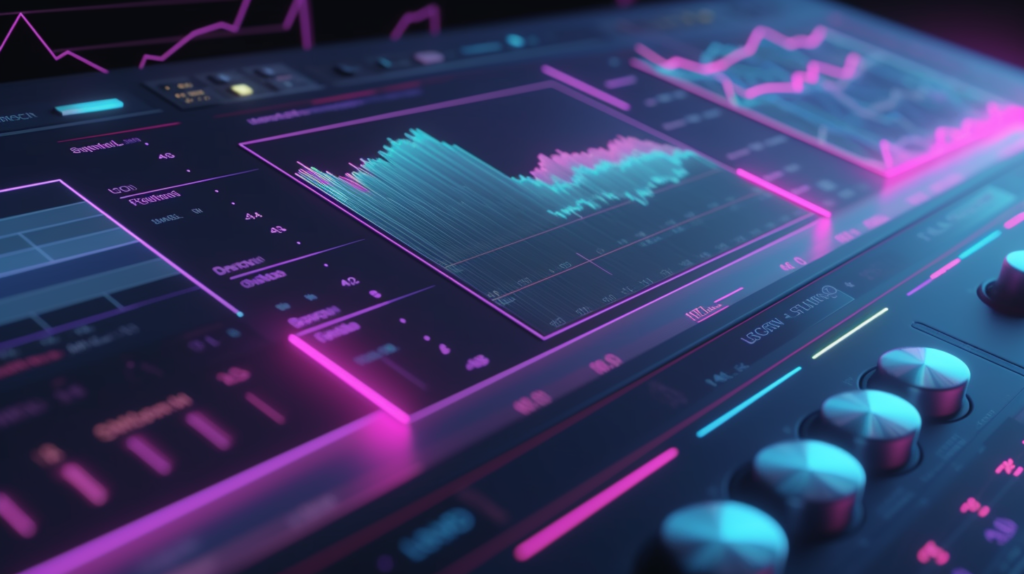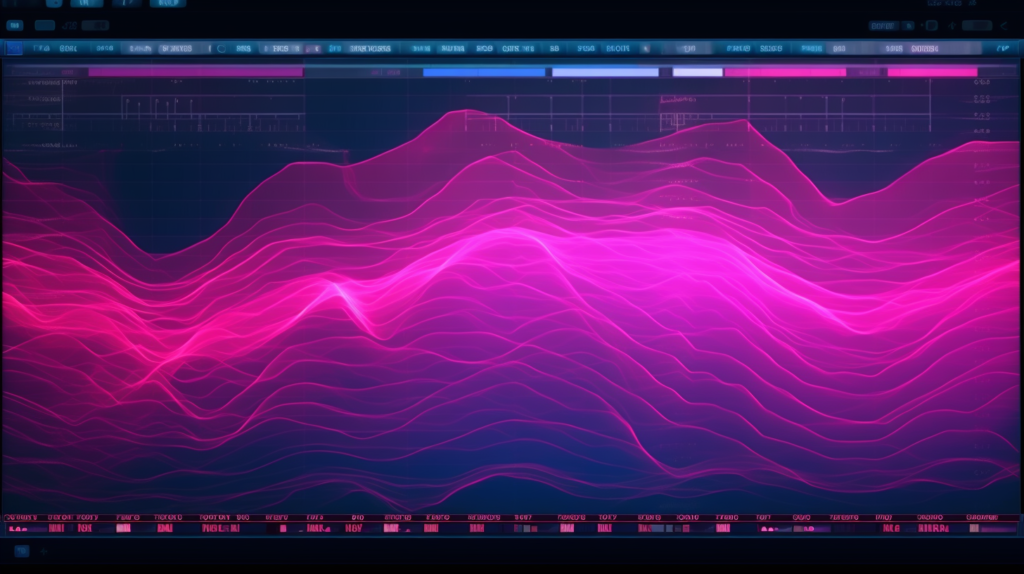
Mastering is the final step in the music production process, ensuring your tracks sound polished and professional. Today, we’ll explore mastering for different formats and platforms, specifically CDs, vinyl records, and digital releases.
The Art of Mastering for CDs
CDs have been a staple in the music industry for decades. Understanding the nuances of mastering for this format can help your music shine on any CD player.
The Loudness Wars and CD Mastering
The Loudness Wars have had a significant impact on CD mastering practices, shaping the way music is processed and delivered to listeners. The term “Loudness Wars” refers to the competitive trend in the music industry, where recordings are pushed to be louder and louder in order to stand out and grab the attention of listeners.
In CD mastering, the goal is to achieve an optimal balance between loudness and dynamic range. Dynamic range refers to the difference between the softest and loudest parts of a song. In the pursuit of loudness, mastering engineers often employ techniques such as heavy compression and limiting to squash the dynamic range and make the music consistently loud throughout.
However, the excessive loudness can come at the expense of sound quality. Heavy compression and limiting can lead to loss of dynamics, reduced clarity, and increased distortion. This phenomenon has been a subject of much debate and criticism within the music industry.
Listeners have become increasingly aware of the negative effects of excessive loudness and have expressed a desire for more dynamic and natural-sounding music. As a response, there has been a growing movement towards embracing the concept of dynamic range in CD mastering.
Modern mastering engineers strive to strike a balance between loudness and dynamics, aiming to deliver music that retains the impact and energy while preserving the nuances and subtleties of the original recording. They employ a variety of techniques, including careful use of compression, equalization, and other processing tools, to enhance the sonic characteristics of the music without sacrificing its dynamic range.
The awareness of the Loudness Wars has brought about a shift in perspective, emphasizing the importance of quality over sheer loudness. This approach ensures that the music on CDs is not only attention-grabbing but also enjoyable and immersive, providing a more satisfying listening experience for the audience.
CD Redbook Standard
The CD Redbook Standard is a set of specifications that dictate how audio should be encoded onto CDs. Adhering to these standards will ensure your music is compatible with most CD players. Key aspects include:
- 16-bit depth
- 44.1 kHz sample rate
- Maximum track count: 99
- Maximum play time: 74 minutes
Dithering for CDs
Dithering is an essential process in mastering music for CDs, particularly when reducing the bit depth of an audio file. It involves the addition of low-level noise to the digital signal, aiming to minimize quantization errors and improve the overall sound quality for the final CD release.
In digital audio production, audio signals are represented by discrete numerical values quantized according to the chosen bit depth. When preparing audio for CDs, a standard bit depth of 16 bits is used. Therefore, if the original audio was recorded and mixed at a higher bit depth, such as 24 or 32 bits, dithering becomes necessary to downsample it to the required 16-bit format.
Dithering employs a controlled amount of low-level noise to mask quantization errors that arise when reducing the bit depth. By introducing this noise, dithering distributes the quantization errors across a broader frequency range, preventing audible harmonic distortion and ensuring smoother transitions between amplitude values. This process is achieved through specialized algorithms that generate the noise signal, taking into account the audio signal’s characteristics and the target bit depth.
By strategically applying dithering during the final stage of digital signal processing, the mastered mix can maintain the highest sound quality while conforming to the 16-bit CD format. Dithering contributes to a more natural and pleasing listening experience for the audience, enhancing the overall quality of the music on CDs.
Vinyl Record Mastering: A Revival of Analog Warmth
Vinyl has made a significant comeback in recent years, providing a nostalgic and tactile listening experience. Mastering for vinyl requires a unique approach, with several factors to consider.
Understanding the Vinyl Cutting Process
Cutting grooves into a lacquer disc is the initial step in vinyl production, and it is during this stage that the audio waveform is represented and later pressed onto the vinyl itself. However, it is crucial for audio engineers and mastering professionals to understand that the cutting process can significantly influence the final audio quality, necessitating careful preparation of the mix.
When preparing a mix for vinyl, several considerations come into play. One of the primary concerns is the dynamic range of the audio. Vinyl records have inherent limitations regarding the amplitude that can be accurately reproduced. Extreme variations in volume, such as excessively loud sections or sudden spikes, can result in distortion or cause the needle to skip across the surface of the record. Therefore, it is essential to carefully manage the dynamic range, ensuring a more consistent and controlled balance between the softest and loudest parts of the mix.
Furthermore, the frequency response of vinyl records is not as wide as that of digital formats or CDs. High-frequency content may require adjustments to avoid issues such as excessive sibilance or the risk of the stylus dislodging from the groove. Certain equalization techniques may be employed during the mastering process to address these considerations, making slight adjustments to the frequency balance to ensure optimal playback on vinyl.
Additionally, the stereo imaging and overall depth of the mix should be considered when mastering for vinyl. The cutting process can be sensitive to stereo width and phase relationships, so it is crucial to ensure a well-balanced stereo image that translates effectively to the vinyl format.
By understanding the intricacies of the vinyl production process and taking the necessary precautions during mastering, audio professionals can optimize the audio quality and ensure the best possible playback experience for vinyl enthusiasts. Careful attention to dynamic range, frequency response, stereo imaging, and other factors can help preserve the unique and cherished sound that vinyl records offer.
Limitations of Vinyl
Vinyl has inherent limitations compared to digital formats. Some considerations when mastering for vinyl include:
- Avoid excessive high-frequency content, which can cause distortion and skipping
- Keep low frequencies centered to prevent the stylus from jumping out of the groove
- Be mindful of the running time, as longer sides can result in a loss of audio quality
The RIAA Curve
The RIAA (Recording Industry Association of America) curve is a standardized equalization curve applied during the cutting process. This curve boosts high frequencies and attenuates low frequencies to reduce noise and improve the playback quality. During the mastering process, apply the inverse RIAA curve to ensure your music sounds as intended on vinyl.
The Fine Details of Mastering for Streaming Platforms
As more and more music listeners flock to streaming services, it’s become crucial for music producers to tailor their mastering process to digital platforms. Services like Spotify, Apple Music, and Tidal each have their unique requirements and recommendations.
The Role of Loudness Normalization
Streaming platforms employ a concept known as loudness normalization to maintain a consistent listening experience. Loudness normalization adjusts tracks to hit a target loudness level, usually expressed in LUFS (Loudness Units Full Scale).
This adjustment has the effect of leveling the playing field. Overly loud tracks will be turned down, while softer tracks will be turned up. As a producer, you must aim for a loudness level that aligns with the target LUFS of the platform where your music will be featured. This ensures your tracks are heard as you intended, without being quietened or unnecessarily amplified.
Compression and Codec Considerations
Streaming services use different audio codecs to reduce file sizes. These codecs are essentially compression algorithms that help to stream music efficiently. However, they can also affect the audio quality, often leading to subtle artifacts and distortion. Here’s a rundown of the codecs used by major platforms:
- Apple Music: This platform uses AAC (Advanced Audio Coding). AAC is known for delivering good sound quality at lower bitrates, making it a favorite for many streaming services.
- Spotify: Spotify streams music in the Ogg Vorbis format. It’s a lossy codec, which means some data is lost during compression. But with good mastering, the sonic losses can be negligible.
- Tidal: Tidal prides itself on providing lossless music streaming, using the MQA (Master Quality Authenticated) format for its highest quality tier. This means you should pay extra attention to maintaining high audio quality when mastering for Tidal.
When preparing your tracks for digital release, simulate the encoding process used by these services to spot and rectify any potential issues. This can help you understand how your music will sound once it’s streamed.
Mastering for Peak Normalization
Many streaming services not only normalize based on loudness, but also on peak level to prevent distortion and clipping. This means tracks with high peak levels may be turned down more than expected. It’s crucial to watch your peak levels during mastering, using tools such as a True Peak Limiter to ensure your music stays distortion-free.
Embracing the Streaming Age
As we embrace the streaming age, it’s essential to tailor our mastering process to meet the demands of digital platforms. By understanding and adapting to loudness normalization, various audio codecs, and peak normalization, we can ensure our music is heard the way we intended, no matter the platform.
Cheatsheet for Producers
| Format | Considerations | Target Loudness |
|---|---|---|
| CD | – Maintain dynamic range – Adhere to Redbook Standard – Apply dithering for 16-bit depth | N/A |
| Vinyl | – Avoid excessive high-frequency content – Center low frequencies – Apply inverse RIAA curve | N/A |
| Digital | – Aim for target LUFS of chosen platform – Test tracks with different codecs – Be aware of loudness normalization | Varies |
Now that you have a comprehensive understanding of mastering for different formats and platforms, you can ensure your music sounds its best on CDs, vinyl records, and digital releases. Remember to adhere to the specific requirements and recommendations of each format, and use the cheatsheet above as a quick reference during the mastering process.





